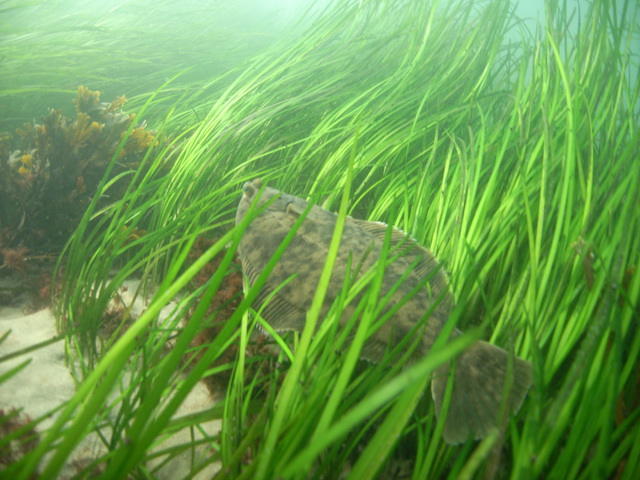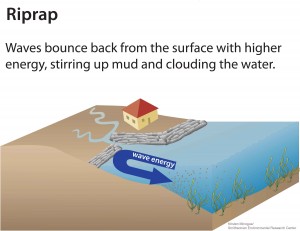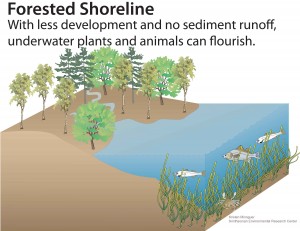by Kristen Minogue

A flounder in a bed of eelgrass. Seagrasses and other underwater plants provide food and shelter to many iconic Bay creatures, including blue crabs. (NOAA)
It’s been a difficult century for the submerged flora of Chesapeake Bay.
In the 1930s, wasting disease nearly wiped out the eelgrasses of the North Atlantic. In the ‘50s and ‘60s, they faced onslaughts from invasive grasses like water chestnut and Eurasian milfoil. Finally, in the summer of 1972, Hurricane Agnes pummeled underwater plants to the lowest levels ever reported in the Bay. This April, they received news that, at first glance, seemed positive: Submerged grasses rose 24 percent between 2012 and 2013, according to aerial surveys of the Chesapeake Bay Program.
But those increases were largely limited to a single species: widgeon grass, a plant known for wild fluctuations. At 60,000 acres total, submerged plants still didn’t come near a recent mini-peak in 2002, they’re a far cry from the ultimate goal of 185,000 acres across the Bay. What is holding them back? And—more importantly—how we can we help ensure the latest expansion isn’t just a blip?
It may boil down to what’s happening on land. To flourish, submerged aquatic vegetation (SAV) needs clear water and plenty of sunlight, which can only happen if shorelines cooperate. Chris Patrick and Don Weller, two ecologists at the Smithsonian Environmental Research Center, ran a study of 100 subestuaries across the Chesapeake and mid-Atlantic coast to find out which types of shorelines are endangering submerged plants, and which could help save them.


 Riprap, jagged rocks used to protect shorelines from erosion, was one of the best predictors of low SAV. High-energy waves bounce off riprap, stirring up sediment and muddying the water. Patrick and Weller discovered just 5.4 percent riprap could make the difference between a subestuary with thriving plants and one where SAV stagnated or dwindled. But Patrick doesn’t view the number as an absolute threshold. The ideal, he said, is for a subestuary to have “little or no” riprap.
Riprap, jagged rocks used to protect shorelines from erosion, was one of the best predictors of low SAV. High-energy waves bounce off riprap, stirring up sediment and muddying the water. Patrick and Weller discovered just 5.4 percent riprap could make the difference between a subestuary with thriving plants and one where SAV stagnated or dwindled. But Patrick doesn’t view the number as an absolute threshold. The ideal, he said, is for a subestuary to have “little or no” riprap.
“I don’t want people to think that once we get above the threshold, it’s in bad shape, so it doesn’t matter what we do,” he said.
Ironically, shoreline marshes also seemed bad for SAV. This discovery startled the scientists at first, considering marshes’ many virtues. “It was a surprise,” Weller said. “We were expecting that marshes would be good for submerged aquatic vegetation, because marshes are natural vegetation, part of the natural system.”
The problem with marshes is that they leak. Dissolved substances from marshes can spread up to a kilometer from shore, clouding the water and blocking light. Furthermore, sand-loving SAV like eelgrass have a hard time growing in muddy marsh sediment. “If you’re getting a lot of this silt that’s settling out, that’s just a poor substrate to grow on for a lot of these submersed plant species,” Patrick said.
But only marshes on the water’s edge had these bad effects. As a whole, wetlands were an asset: More total wetland in a watershed was the strongest positive predictor of more SAV in a subestuary. Forests were another boon for SAV, both on and above the shore. It also helped to have plenty of shallow water (6 feet deep or less), where sunlight could reach the underwater plants and destructive wave energy was weakened.
How You Can Help Protect SAV:
- Plant a rain garden to absorb stormwater runoff.
- Use less fertilizer. The best times to apply it are right after rainstorms, when it’s less likely to wash off.
- Keep your septic system in good condition. The EPA recommends getting them inspected every three years.
- Replace riprap or bulkhead with a living shoreline.
- Visit Ecosystems on the Edge for more ideas.

